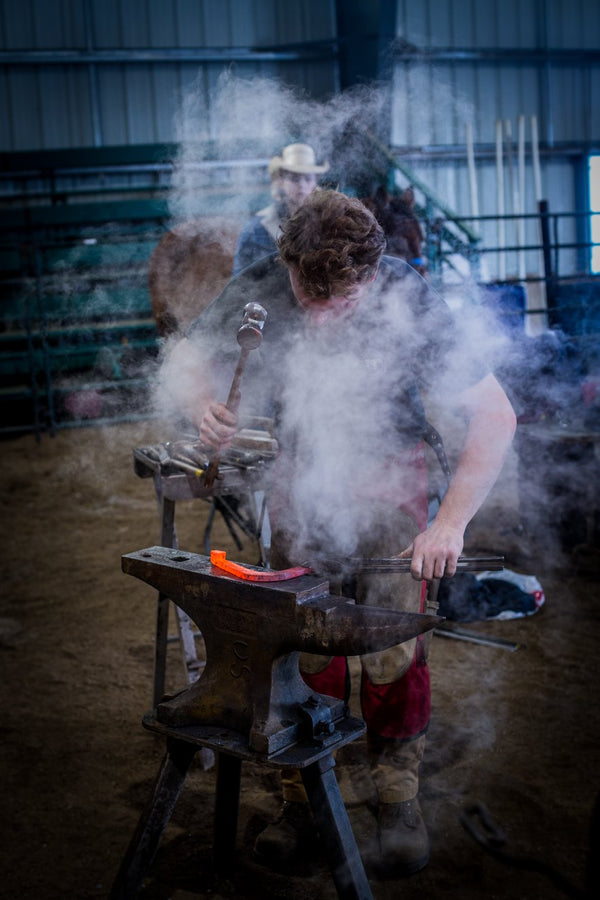Alien Skin is a fine, high-temperature, flexible, phosphate refractory with excellent bonding to existing old refractories. It can be used as is and pressed/ hammered into place, or mixed with water and used from a trowellable plaster to a paintable wash coat.
Add 4% water and you have a thick paste, 8% and you have a sour cream mix you can spread with a spatula, or add more and you can apply a brush coat with a paintbrush (Some applications use up to 40% water - though this is rare in most applications)
Be Creative. Apply a single coat to a clean solid base, OR-
Layering & Mix option: A)Begin with an initial runny coat of Alien Skin so it 'bites' into the existing base material, followed by B)A second, heavier layer for optimal adhesion and strength. Save enough for a very thin coat after your forge has fired once - to seal any checks that develop. (Your 3 coats can still be as little as 3/16" thick if thinly applied).
If you want to go the extra mile - especially useful for wide spanning ceiling application - consider:
Weldable 'wool blanket push on pins & clips'are a great way for wool (especially heavy wool) to defy gravity (ie ceilings, tall side walls). Two great ways to keep your wool hard coating ON THE WOOL BLANKET are:
1) Have the wool retention clips embedded in your blanket's castable 'skin coat', and/or
2) Consider 'Dragon Skin'as your base coat - it permeates into deeper layers of your rigidized wool for optimal 'grab'.
ie, TUCK tape sticks to most everything. It will even stick to cotton batting. But it will come off easily, because it only bonds to the surface fibers, which themselves easily pull off on the back of the tape. Well applied Dragon's Skin holds deep; it grows roots.
For one of the strongest and most durable thin 'skin-coats' we've ever found for wool:
A) Apply a coat of Dragon Skin to well-rigidized ceramic wool insulation, then, once fully dry;
B) Apply a coat of Alien Skin to this base coat.
Few materials grab wool like Dragon Skin does (it permeates into ceramic woolin a gradient for a few millimeters when applied properly). The absolute best bonding is a light base coat of Dragon Skin followed with a working face skin coat of the 'stick to anything 'ALIEN-skin' (FYI Alien skin adheres to a wool blanket quite well on its own, but it can be a bit like Tuck Tape. A tip if used without Dragon Skin: Apply it in two layers, the first being 'a watered-down runny base /first coat, then followed by a heavier 2nd coat layer. For a deeply penetrating, strong, thin wool blanket coating, apply Dragon Skin First. Ceilings needing optimal bonding can like this combo.
NOTE: Wool & Board can be held in place with 304ss Wool Retention Pins & One-Way Push on Clips or Twist Locks.
These thin 'skin-coats' can be superior to thicker blanket coating with an insulating castable (like KOL-30-Li+, or GreenLite 45 L+) when you can't spare the room (ie: when, in a foundry there is limited space for the crucible).
Versatile. Great as a thin coat repair to many old refractories. It is easy to work with a comfortable working time (30 minutes is typical). Apply it by brush, spatula, trowel, or with a hammer, depending on if and how much water is added.
Dragon Skin & Alien Skin both add efficiency (optimal reflectivity) and respiratory safety (sealing an asbestos-like fibre) to ceramic wool insulation.
For maximum firebox energy efficiency and performance, finish your final wool coating with a thin 'brush-coat' (or rub) of ITC-100 HT. A little ITC-100 goes a long way when it is applied to a hard surface coating. An ITC coating on Dragon Skin, KOL-30, or Alien Skin will go 10x further than when used directly on rigidizedwool.
Although overkill, Alien Skin can be a great fireplace 'Patch & Repair' Product. It bonds easily to old bricks and refractory surfaces. It can help make cracked bricks serviceable and it can double as an extreme service mortar.
At 90% Alumina, Alien Skin 90+ provides decent flux resistance, even when applied as a brush coating to insulating castables like KOL 30 Li (G)+, Greenlite 45L (online), or others where flux resistance is likely to be encountered.
About Flux Resistance A layer of Greencast 94+ vibration cast to avoid surface bubbles is to welding flux what Teflon is to eggs on a skillet. Ultra-Express 70 is also impervious to flux (not damaged by it, though the flux sticks). Properly cast, both get stronger with heat, to 20,000+ psi at 3200°F!
A 90% Alumina

